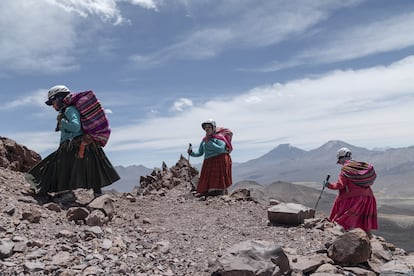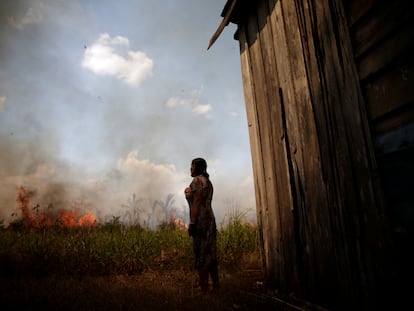Little by little, Indigenous territory in Latin America has grown
In 16 Central and South American countries analyzed in a report by the Rights and Resources Initiative, the area allocated to Indigenous and Afro-descendant communities increased by 52 million acres in five years

Latin America has been a pioneering region in terms of recognizing the territorial rights of Afro-descendant and Indigenous communities. However, in recent years, it has been falling behind. This is stated in a report — Who Owns the World’s Land? — published on June 15 by the Rights and Resource Initiative (RRI). The international NGO examined 73 countries, which together cover 85% of the earth’s surface, to see what percentage of territory belongs to Indigenous and Afro-descendent communities: or, at least, what amount of territory has officially been designated to them.
Globally, between 2015 and 2020 — the period that the report evaluated — the total area of land controlled by these groups increased by 254 million acres. However, in Latin America, barely 52 million acres were added. Specifically, across the region, the lands designated to Indigenous or Afro communities (that is, they have use of them, but don’t own them), increased by nearly 10 million acres, from 3% in 2015 to 3.2% in 2020. Meanwhile, the lands that these communities officially own grew by 42 million acres, from 16.7% to 17.6% of overall territory.

“Latin America made a lot of progress on this issue in the 1980s and 1990s,” says Omaira Bolaños, director of RRI’s Latin America and Gender Justice program. “But, since then, [regarding] what remains pending, the allocation of new Indigenous territories has been very slow.” She explains that, while the overall figure is good news, she also cautions that this increase is only due to what happened in 38 of the 73 countries analyzed, most of which are located in Africa.
Given this closer analysis of the situation, Levi Sucre — Indigenous leader and representative of the Global Alliance of Territorial Communities — also believes that it’s a somewhat discouraging scenario. “We’re alarmed that the recognition of Indigenous lands and communities is stagnant, because it means that our forests are vulnerable to extractivism; that our lives and cultures are at risk and that all of humanity is losing the chance to fight the climate crisis. Governments continue to make promises to mitigate climate change [as we near] 2030, but they don’t title land, which is the most effective and efficient way to protect forests,” he points out.
According to the RRI report, in the 16 Latin American countries analyzed, around 79% of total land is in the hands of the state or private individuals, 18% is owned by Afro-descendant or Indigenous communities, while 3% has been designated for the collective use of these populations.
What’s happening in Latin America?
According to the report, one of the countries that helped improve the outlook for the region during this five-year-long period was the Republic of Panama. In the Central American country, following the final ruling in a case that reached the Supreme Court, the Naso Tjër Indigenous community took ownership of nearly 400,000 acres of land, which marked a new legal precedent.
“There has always been a limitation, because in Panama, it was considered that territory within protected areas couldn’t be demarcated for Indigenous people,” Bolaños notes. But following this action by the courts, it was clearly recognized that conservation and the presence of Indigenous people are coherent concepts. “As other research has shown, there’s less deforestation and greater biodiversity where Indigenous people live,” the expert adds.
In other countries, such as Guyana, progress was also made. The country recognized the Kanashen Amerindian Protected Area — the first of its kind — which covers 3% of Guyana’s total land area.
The problem, the report stresses, is that — in addition to the fact that Latin America has begun to fall behind in demarcating new areas for Afro and Indigenous peoples — the titles that already exist (at least on paper) are experiencing serious threats. One of the most high-profile cases was in Brazil, when former president Jair Bolsonaro cut funding to the National Indian Foundation and issued an order giving Brazil’s Ministry of Agriculture greater power over Indigenous lands. In Peru, the report also points out, the communities of the Amazon and the Andes have had to file lawsuits to protect their territory in the face of pressure from oil and mining companies, who have been given concessions in the central regions without consulting the communities who inhabit the territory. Similar examples could be cited in almost any Latin American country.
Bolaños warns that so long as the region continues to maintain an economic model based on the extraction of natural resources, there will always be pressure not only to recognize new Afro and Indigenous territories, but to bolster those that already have protected status.
Sign up for our weekly newsletter to get more English-language news coverage from EL PAÍS USA Edition
Tu suscripción se está usando en otro dispositivo
¿Quieres añadir otro usuario a tu suscripción?
Si continúas leyendo en este dispositivo, no se podrá leer en el otro.
FlechaTu suscripción se está usando en otro dispositivo y solo puedes acceder a EL PAÍS desde un dispositivo a la vez.
Si quieres compartir tu cuenta, cambia tu suscripción a la modalidad Premium, así podrás añadir otro usuario. Cada uno accederá con su propia cuenta de email, lo que os permitirá personalizar vuestra experiencia en EL PAÍS.
¿Tienes una suscripción de empresa? Accede aquí para contratar más cuentas.
En el caso de no saber quién está usando tu cuenta, te recomendamos cambiar tu contraseña aquí.
Si decides continuar compartiendo tu cuenta, este mensaje se mostrará en tu dispositivo y en el de la otra persona que está usando tu cuenta de forma indefinida, afectando a tu experiencia de lectura. Puedes consultar aquí los términos y condiciones de la suscripción digital.
More information
Archived In
Últimas noticias
Most viewed
- Sinaloa Cartel war is taking its toll on Los Chapitos
- Oona Chaplin: ‘I told James Cameron that I was living in a treehouse and starting a permaculture project with a friend’
- Reinhard Genzel, Nobel laureate in physics: ‘One-minute videos will never give you the truth’
- Why the price of coffee has skyrocketed: from Brazilian plantations to specialty coffee houses
- Silver prices are going crazy: This is what’s fueling the rally










































